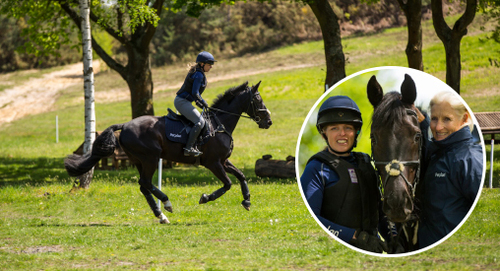
Lucinda Green's golden rules for cross-country riding
We joined Lucinda Green and Petplan Equine Ambassador Juliette Edmonds for a cross-country lesson, and discovered three golden rules every rider can benefit from.
Lucinda Green, MBE, a six-time Badminton winner and former World Eventing Champion, has been training riders for more than 35 years. And she's a firm believer in the idea that there's a science behind cross-country riding – it's not just about sitting on a horse, going flat out.
'For me, there are three golden rules that you should have in mind when you're riding cross-country,' she says. 'They make up the word “elbow”, which stands for “engine”, “line” and “balance”, and these are the things every rider needs to look after. The last part of elbow is “ow” – for “ouch” if you forget one of them!'
Read on to find out how Petplan Equine Ambassador Juliette Edmonds put each of these points into practice during her lesson with Lucinda.
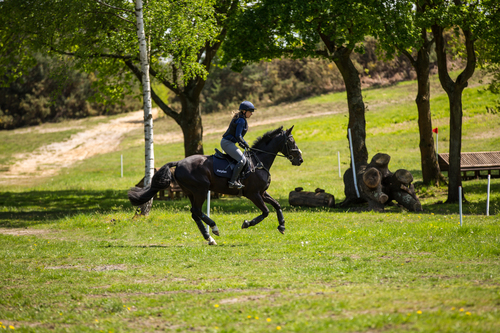
1. Engine: keep your horse going
After a good warm-up, Lucinda asks Juliette to canter her horse, Bubba Gump (Boodles), around the cross-country field with the aim of building a 'desiring' canter.
'The first thing you need to do is get a positive canter,' she explains. 'You want to be able to push your horse forwards into the cross-country canter, and then bring him back again to ensure he's in front of the leg. With a very hot horse you want to keep the same rhythm. You want to feel like your horse is taking you.'
Boodles has a lovely forward canter and it's clear he is in front of the leg with plenty of desire to take Juliette into a fence.
Lucinda then asks Juliette to find a straightforward fence to jump, giving Boodles plenty of time to see it. 'You ideally want your horse to see the fence early, and have the desire to take you into it. I always recommend walking the course beforehand, as that way you'll be able to regulate the speed that you know the fence needs,' she adds.
'You don't want your horse too much on the bit coming into a fence. You actually want him to have his head up slightly so that he can see the fence in plenty of time. Nothing frightens a horse more than suddenly being presented with a fence that he hasn't had the chance to assess properly.'
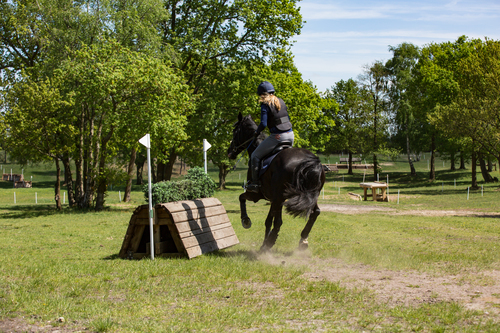
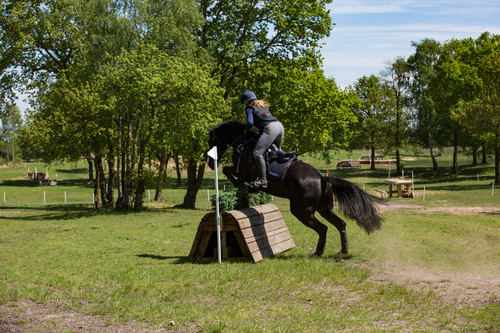
2. Line: keep a good line into the fence
'When walking the course, it's important to study the line you want to take,' says Lucinda. 'It might be that you'll need to approach it at an angle or perpendicularly, and it will of course depend on where you are going next. Again, the most important thing is to make sure that your horse can see where he is going well ahead of time.'
Juliette jumps Boodles up a bank and then makes a right-handed turn to an upright brush fence, but the first attempt sees Boodles run out.
'You want to attach an invisible wire from your calf to his eyes, and sit up ready for trouble,' says Lucinda. 'Try to make sure your horse is looking where you are. That's why you can't just steer with your hands – you've got to feel that your horse's eyes are attached to your legs. When I say leg, I don't mean kick, I mean using your leg to connect your horse to the fence. Sit and wait, and let him take you.'
With this in mind, the next attempt is more successful: Juliette uses her legs to steer Boodles after the bank, which gives him more time to see the fence, meaning he locks on and makes a clean jump.
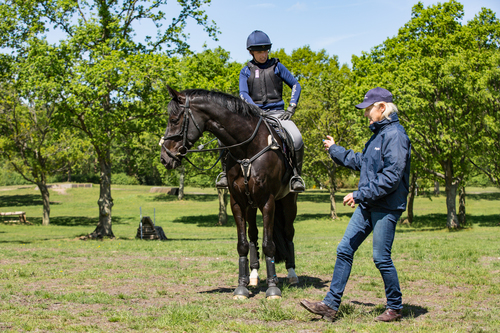
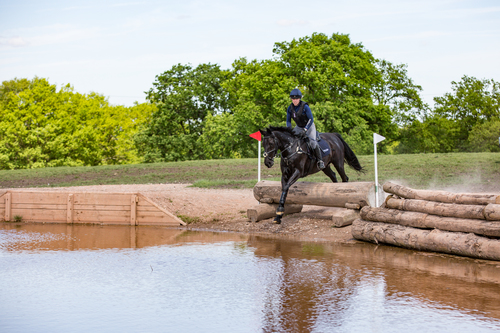
3. Balance: keep your seat
Lucinda notices that Juliette sometimes allows her body to tip forwards on approach to the fence. She explains that a good cross-country seat is especially important, so that a rider is always in balance should a problem arise.
'Whether your horse pops in a short stride or takes off on a long one, your job is to sit in a balanced position that allows him to do either,' Lucinda says. 'Your shoulders should stay above your hips. This will give your horse the freedom to get his own shoulders up and out of trouble if he gets in deep or decides to stand off. And being in the correct balance before a fence will give your horse a sense of safety. Some horses won't jump unless you draw yourself back on takeoff, because otherwise you're in front of the movement.'
Lucinda explains that a rider's leg and hand are also key to staying in balance. 'The rider's job is never to leave that position of defence, and so your lower leg is crucial. It should feel like your leg is cuddling the saddle, not gripping it.
'Your reins should also be long enough to help you keep your position, and not creep forward and allow your leg to go too far behind you. Try softening your fingers on the reins on landing, so that your horse can stretch forwards and down if he wants. This will allow him to use his “fifth leg” (his head and neck) to help him stay upright.'
Juliette puts this into action when jumping down the step into the water complex, keeping her lower leg secure under her hips and keeping her body upright and not in front of Boodles' movement.
When it comes to your horse's balance, Lucinda says that the only bad balance a horse can have is when his head is too low. 'As long as your horse has plenty of “engine”, you don't have to worry about his balance,' Lucinda explains. 'If you have the engine, you have the balance.'



